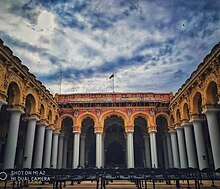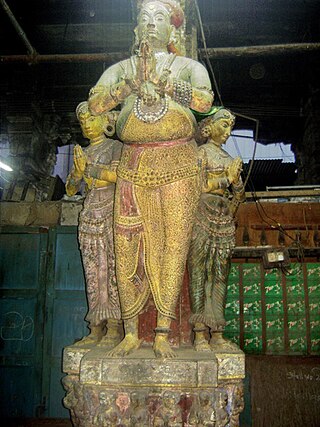
Tirumala Nayaka was the ruler of Madurai Nayak Dynasty in the 17th century. He ruled Madurai between A.D 1623 and 1659. His contributions are found in the many splendid buildings and temples of Madurai. He belongs to Balija caste. His kingdom was under constant threat from the armies of Bijapur Sultanate and the other neighbouring Muslim kingdoms, which he managed to repulse successfully. His territories comprised much of the old Pandya territories which included Coimbatore, Tirunelveli, Madurai districts, Aragalur in southern Tamil Nadu and some territories of the Travancore kingdom.

Madurai district is one of the 38 districts of the state of Tamil Nadu in southeastern India. The city of Madurai serves as the district headquarters. It houses the famous Sri Meenakshi Sundareshwarar temple and is situated on the banks of the river Vaigai. Thiruparankundram is one of the major tourist place in the district. As of 2011, the district had a population of 3,038,252 with a sex-ratio of 990 females for every 1,000 males. Aside from the city of Madurai, the larger towns are Melur, Vadipatti, Thirumangalam, Thirupparankundram, Peraiyur, and Usilampatti. It is an important hub for various film shootings. Alanganallur is a popular spot in the district for Jallikattu, as are Palamedu and Avaniyapuram.

The Thanjavur Nayakdynasty were the rulers of Thanjavur in the 15th and 17th centuries. The Nayaks, who belonged to the Telugu-speaking Balija social group were originally appointed as provincial governors by the Vijayanagara Emperor in the 15th century, who divided the territory into Nayak kingdoms which were Madurai, Tanjore, Gingee and Kalahasthi. In the mid-15th century they became an independent kingdom, although they continued their alliance with the Vijayanagara Empire. The Thanjavur Nayaks were notable for their patronage of literature and the arts.
Nayaka dynasties emerged during the Kakatiya dynasty and the Vijayanagara Empire period. The Nayakas were originally military governors under the Vijayanagara Empire. After the battle of Talikota, several of them declared themselves independent.

The Dindigul Fort or Dindigul Malai Kottai and Abirami amman Kalaheswarar Temple was built in 16th-century by Madurai Nayakar Dynasty situated in the town of Dindigul in the state of Tamil Nadu in India. The fort was built by the Madurai Nayakar king Muthu Krishnappa Nayakar in 1605. In the 18th century the fort passed on to Kingdom of Mysore. Later it was occupied by Hyder Ali and Tipu Sultan the fort was of strategic importance. In 1799 it went to the control of the British East India Company during the Polygar Wars. There is an abandoned temple on its peak apart from few cannons sealed with balls inside. In modern times, the fort is maintained by the Archaeological Survey of India and is open to tourists.

Arulmigu Meenakshi Sundareswarar Temple a.k.a Arulmigu Meenakshi Amman Thirukkovil is a historic Hindu temple located on the southern bank of the Vaigai River in the temple city of Madurai, Tamil Nadu, India. It is dedicated to the goddess Meenakshi, a form of Shakti, and her consort, Sundareshwarar, a form of Shiva. The temple is at the centre of the ancient temple city of Madurai mentioned in the Tamil Sangam literature, with the goddess temple mentioned in 6th-century CE texts. This temple is one of the Paadal Petra Sthalams, which are 275 temples of Shiva that are revered in the verses of Tamil Saiva Nayanars of the 6th-9th century CE.
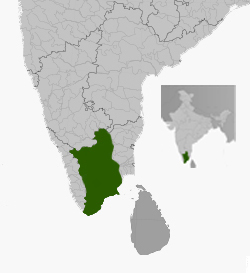
The Madurai Nayaks were a Telugu dynasty who ruled most of modern-day Tamil Nadu, India, with Madurai as their capital. The Madurai Nayaks had their origins in the Balija Chetti merchants clans of present-day Andhra Pradesh. The Nayak reign which lasted for over two centuries from around 1529 to 1736 was noted for its achievements in arts, cultural and administrative reforms, revitalization of temples previously ransacked by the Delhi Sultans, and the inauguration of a unique architectural style.

Palaiyakkarars, or Poligar, Palegara in Andhra, Karnataka and Tamil Nadu refers to the holder of a small kingdom as a feudatory to a greater sovereign. Under this system, palayam was given for valuable military services rendered by any individual. The word pālayam means domain, a military camp, or a small kingdom. This type of Palayakkarars system was in practice during the rule of Pratapa Rudhra of Warangal in the Kakatiya kingdom. The system was put in place in Tamil Nadu by Viswanatha Nayak, when he became the Nayak ruler of Madurai in 1529, with the support of his minister Ariyanathar. Traditionally there were supposed to be 72 Palayakkarars. The majority of those Palaiyakkarar, who during the late 17th- and 18th-centuries controlled much of the Telugu region as well as the Tamil area, had themselves come from the Kallar, Maravar and Vatuka communities.

Tiruchirappalli Rock Fort, locally known as Malaikottai, is a historic fortification and temple complex built on an ancient rock. It is located in the city of Tiruchirappalli, on the banks of river Kaveri, Tamil Nadu, India. It is constructed on an 83 metres (272 ft) high rock. There are two Hindu temples inside, the Ucchi Pillayar Temple, Rockfort and the Thayumanaswami Temple, Rockfort. Other local tourist attractions include the famous Pallava-era Ganesha temple and the Madurai Nayak-era fort. The fort complex has witnessed fierce battles between the Madurai Nayakas and Adil Shahi dynasty of Bijapur, Carnatic region and Maratha Imperial forces. The fort played an important part during the Carnatic Wars, helping lay the foundations of the British Empire in India. The Rockfort is the most prominent landmark of the city.

The Sethupathis are a Tamil clan of the Maravar community native to the Ramanathapuram and Sivaganga district of Tamil Nadu, India. They were from the 12th century considered independent kings in 16th century who ruled the Ramnad kingdom, also known as Maravar country. The male rulers of Ramnathapuram also bore the title of "Sethupathi" or "protector of the bridge", the bridge here referring to the legendary sacred Rama's Bridge, while female rulers bore the title "Nachiyar". Among the 72 poligars of the region, the Sethupathi stood first. This special position was conferred not based upon the revenue that his kingdom generated but because of his military prowess. Back in the beginning of the 18th century, the Sethupathi ruler could mobilize a considerable army, about 30,000 to 40,000 strong at short notice.

The Nayaks of Gingee (Senji) were Telugu rulers of the Gingee principality of Tamil Nadu between 16th to 18th century CE. They were subordinates of the imperial Vijayanagara emperors, and were appointed as provincial governors by the Vijayanagar Emperor who divided the Tamil country into three Nayakships viz., Madurai, Tanjore and Gingee. Later, after the fall of the Vijayanagara's Tuluva dynasty, the Gingee rulers declared independence. While they ruled independently, they were sometimes at war with the Tanjore neighbors and the Vijayanagara overlords later based in Vellore and Chandragiri. The Gingee Nayaks had their origins in the Balija Merchant clans of present-day Andhra Pradesh.

Tiruchirappalli Fort is a dilapidated fort in India which once protected the Old City of Trichy encompassing Big Bazaar Street, Singarathope, Bishop Heber School, Teppakulam and Tiruchirapalli Rock Fort. All that remains now is a railway station with that name and Main Guard Gate along West Boulevard Road in the city of Tiruchirappalli in Tamil Nadu. The fort can be traced along West Boulevard Road in West, East Boulevard Road in East, Butter-worth Road in North and Gandhi Market to the South.

Vandiyur Mariamman Teppakulam is a temple tank located near to Vandiyur Mariamman Temple and situated at a distance of about 5 km from the Meenakshi Amman Temple. Literally, Teppakulam means temple pond mainly used for devotional festivals.
Nilakantha Diksita was a minister in the 17th century court of King Thirumalai Nayak of Madurai. He composed several poems and literary works, including Ananda Sagara Stavam.
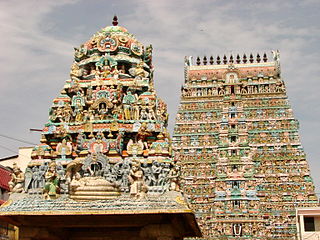
Tamil Nadu is known for its ancient temple architecture. Nearly 33,000 ancient temples, many at least 800 to 2000 years old, are found scattered all over Tamil Nadu. As per Tamil Nadu Hindu Endowments Board, there are 38,615 temples. Most of the largest Hindu Temples reside here. Studded with complex architecture, a variety of sculptures, and rich inscriptions, the temples remain the very essence of the culture and heritage of Tamil land, with historical records dating back to at least 3,000 years.
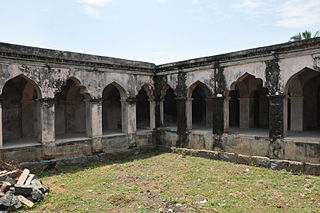
Attur Fort is a historic fort present in Attur in Salem district in the South Indian state of Tamil Nadu. The fort is located on the banks of river Vashista, 56 km (35 mi) away from Salem.The fort was built by a Palaiyakkarar chieftain Gatti Mudaliar dynasty under Madurai Nayaks, called Lakshmana Nayakan during the 17th century.
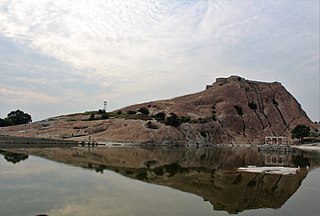
Namakkal Fort is a historic fort present in Namakkal in Namakkal district in the South Indian state of Tamil Nadu. The fort was built during the reign of Thirumalai Nayak of Madurai in 17th century. It was under the dominion of Tipu Sultan and then switched hands to the British East India Company as a part of Srirangapattinam treaty. The fort was used as a watch tower and garrison by the ruling empire.
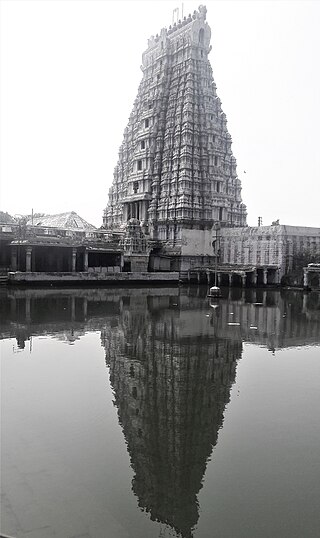
Madavar Vilagam Vaidyanathar temple is a Shiva temple located in Madavar Vilagam, located in one kilometer southerly to Srivilliputhur in Virudhunagar district in the South Indian state of Tamil Nadu, is dedicated to the Hindu god Shiva. Constructed in the Dravidian style of architecture, the temple has two precincts. Shiva is worshiped as Vaidyanathar and his consort Parvati as Sivakami. The temple is the largest Shiva temple in the district. Shiva is worshipped as Vaidyanathar or the "God of healing". The holy water of the Siddhamirtham tank in the temple complex is believed to have curative effects, and a holy dip here is believed to cure all diseases. The temple was built by Thirumalai Nayak during the 16th century.

Tenkasi Pandyas were the Pandya kings from Sadaavarman Parakrama Pandya to his successors who ruled with Tenkasi as their capital. With the invasion of the Sultanates, Vijayanagaras, and Nayakars from the fourteenth century onwards, the Pandyas lost their traditional capital of Madurai and shifted to cities like Tenkasi and Tirunelveli. Tenkasi was the last capital of the Pandyas. All the Pandyas from Sadaavarman Parakrama Pandya and his next generations were crowned in the Adheenam Mutt in Kasi Viswanathar temple. During the same period, some Pandyas ruled with Tirunelveli as their capital. Kayatharu, Vadakkuvalliyur, and Ukkirankottai are some of their major cities. Inscriptions on them are found in Tenkasi's Kasi Viswanathar temple, Brahmadesam, Cheranmadevi, Ambasamudram, Kalakkad and Pudukkottai. The last Pandyan king to be known in the history of the Pandyas was Kolakonda, who was also among the Tenkasi Pandyas.






